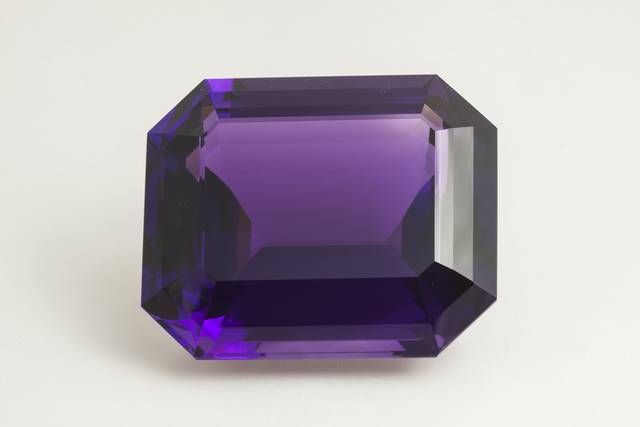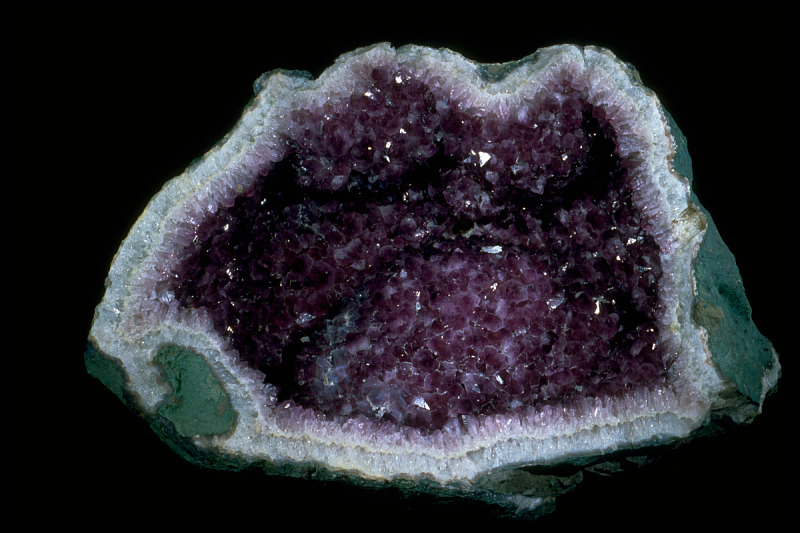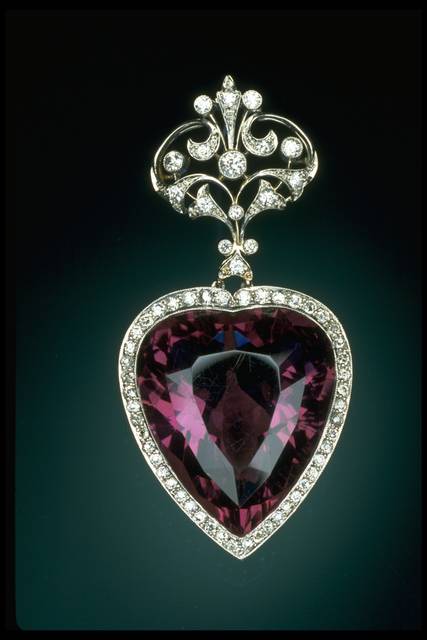
Ametista
Ametista: storia e tradizione
L’ametista, varietà di quarzo cristallino (SiO2) dall’inconfondibile color porpora-violaceo, è una delle gemme più apprezzate sin dai tempi antichi, sia per la sua bellezza che per le numerose doti apotropaiche che le sono state attribuite nel corso della storia.
L’ametista era già nota tra le civiltà del III millennio a.C. e ha sempre occupato un posto d’onore tra le gemme. Delle dodici pietre presenti nel pettorale del sommo sacerdote Aronne, citato nel libro dell’Esodo, la nona è rappresentata dall’ametista (Esodo 28:17-21). Gli antichi egizi, così come gli antichi greci e romani, utilizzavano spesso l’ametista per la fabbricazione di sigilli, gioielli e intagli dal forte valore simbolico ed esoterico. Si riteneva, infatti, che l’ametista favorisse l’intelletto, rendesse invincibili in battaglia e avesse diverse proprietà magiche, in particolare quella di contrastare l’ebrezza in virtù del suo colore che ricordava le tonalità violacee del vino. Non a caso il nome dell’ametista deriva dal greco améthystos (oppure amethysmenos), che significa letteralmente “non-ubriaco”.
Il legame tra l’ametista e l’elisir di lunga vita è una costante che si ritrova in molte fonti storico-mitologiche del passato. Il nome stesso rimanda ad un’antica leggenda che vede protagonisti il dio greco del vino Dioniso (Bacco per gli antichi romani) e Ametista, una ninfa del corteo della dea Artemide (Diana per gli antichi romani): la ninfa Ametista, per sfuggire all’estasi etilica del dio Dioniso, si rivolse alla dea Artemide che la trasformò in un cristallo di quarzo purissimo, cui Dioniso, forse per rimorso, conferì successivamente le tinte purpuree del vino e la proprietà di proteggere contro gli effetti dell’alcool.
Lo storico romano Plinio il Vecchio (23-79 d.C.), nel trentasettesimo volume del suo famoso manoscritto Naturalis Historia, non solo cita le proprietà magiche e gemmologiche delle ametiste, ma spiega anche che “la ragione del nome la si spiega col fatto che il loro bagliore si avvicina al colore del vino ma prima di assorbirlo sfuma nel viola; secondo altri, col fatto che in quella porpora c’è qualcosa che non è totalmente rosso-fuoco, ma sfuma nel colore del vino”.
Poiché in passato l’ametista era una gemma molto rara e preziosa, fu spesso associata anche al potere e alla regalità, soprattutto a partire dal Medioevo. Per tale motivo l’ametista è stata la gemma preferita dai dignitari ecclesiastici, dall’aristocrazia e dalla nobiltà delle grandi corti asiatiche ed europee, dai quali ci pervengono splendidi gioielli e manufatti con ametiste tagliate e incastonate.
Con la scoperta dei grandi giacimenti brasiliani nel XIX secolo, il fascino regale dell’ametista è diventato ampiamente accessibile e ancora oggi questa gemma continua a donare il suo valore simbolico a gioielli e oggetti ornamentali dall’allure mistica e suggestiva.
Secondo la tradizione astrologica, inoltre, l’ametista rappresenta l’amuleto per i nati a febbraio, mese da sempre legato all’amore e al romanticismo.
Ametista: geologia e distribuzione geografica
Nonostante il quarzo sia uno dei minerali più abbondanti della crosta terrestre e comune in molti contesti geologici, esso assume la tipica colorazione dell’ametista solo quando all’interno della sua struttura cristallina sono disperse impurità di ferro e altri elementi chimici che formano centri di colore.
L’ametista da gemma si rinviene tipicamente sotto forma di cristalli ben formati, di sovente riuniti in druse o in geodi, entro cavità di rocce ignee basiche o di pegmatiti, oppure in vene di origine idrotermale. I cristalli di ametista possono raggiungere dimensioni notevoli e sono tipici quelli con abito prismatico esagonale, le cui facce sono striate in senso orizzontale e terminanti ai due vertici con facce romboedriche che simulano una bipiramide esagonale. Spesso l’ametista si ritrova anche nelle sabbie alluvionali, ossia all’interno di giacimenti secondari prodotti dalla degradazione dei giacimenti primari.
Le miniere storiche di ametista si trovano negli Urali in Russia e nell’area di Idar-Oberstein della Germania occidentale. Attualmente l’ametista si estrae in diverse località mondiali, con il maggiore produttore rappresentato dal Brasile, dove si estraggono centinaia di tonnellate di pietre all’anno, in particolare nei giacimenti degli stati di Minas Gerais, Bahia e Rio Grande do Sul. Altri giacimenti importanti si trovano in Uruguay, Bolivia, Messico (Guerrero), Canada, USA (Arizona, Maine), India, Sri Lanka, Myanmar, Namibia, Zambia e Madagascar.
Ametista: aspetti qualitativi
Ciò che rende l’ametista una delle varietà di quarzo tutt’oggi considerate tra le più pregiate e utilizzate in campo gemmologico è senz’altro il suo magnifico colore contraddistinto da diverse tonalità di violetto, le quali spaziano dal mauve rosato al viola intenso, con diverse componenti porpora e blu. Gli esemplari di ametista più belli sono quelli caratterizzati da elevata trasparenza e un color porpora particolarmente vivido, spesso note in commercio come ametiste siberiane per via della tradizione che associa questa particolare tinta alle pietre provenienti dalle storiche miniere della Russia.
Nelle ametiste di origine naturale la distribuzione del colore non è sempre omogenea. Spesso si possono osservare quelle che vengono chiamate zonature di colore, le quali, nel caso dell’ametista, consistono in bande angolari caratterizzate da settori color viola intenso alternati a settori quasi incolori. All’interno dell’ametista, inoltre, vi sono tipiche inclusioni, quali impronte digitali il cui aspetto ricorda il manto di una tigre e cristalli aciculari di diverse specie minerali, talora aggregati in ciuffi, la cui natura riflette l’ambiente geologico di formazione dell’ametista che li ospita.
Dal punto di vista delle proprietà fisiche, l’ametista è una gemma relativamente dura, con un valore 7 secondo la scala di Mohs – che va da 1 a 10 -, pertanto, è piuttosto resistente nei confronti di graffi e abrasioni. Se esposta in modo prolungata al sole, l’ametista può sbiadire e, se riscaldata a temperature di circa 400-500°C, può mutare il suo colore in giallo o in verde, trasformandosi, rispettivamente, nelle varietà quarzo citrino e quarzo prasiolite. Viceversa, il riscaldamento a basse temperature dell’ametista viene spesso effettuato con lo scopo di schiarire alcune ametiste ritenute troppo scure e, quindi, poco appetibili dal punto di vista commerciale. Sul mercato, inoltre, circolano numerose imitazioni dell’ametista, tra cui vetro, zirconia cubica, spinello e corindone sintetici, così come ametiste sintetiche, la cui individuazione richiede sempre l’ausilio di un gemmologo esperto, soprattutto per discriminare i prodotti di sintesi.
Caratteristiche chimico-fisiche dell'ametista
| Specie mineralogica - mineral species | Quarzo - quartz |
| Composizione chimica - chemistry | SiO2 biossido di silicio - silicon dioxide |
| Sistema cristallino - crystal system | Trigonale - trigonal |
| Indice di rifrazione - refractive index | 1.544 (ω) – 1.553 (ε) |
| Carattere ottico - optical character | Uniassico positivo - positive uniaxal (+) |
| Birifrangenza - birefringence | 0.009 |
| Colore - color | Viola / porpora - Violet / purple |
| Densità - specific gravity | 2.65 g/cm3 |
| Durezza - hardness (Mohs) | 7 |


Amethyst: history and lore
Amethyst, a variety of crystalline quartz (SiO2) with a distinct purple-violet color, is one of the most popular gems since ancient times, both for its beauty and the numerous mystical properties, which have been attributed to it throughout history.
Amethyst was already known among the civilizations of the third millennium BC and has always occupied a place of honor among gems. Of the twelve gemstones mounted in the Priestly Breastplate, mentioned in the book of Exodus, the ninth is represented by the amethyst (Exodus 28: 17-21). The ancient Egyptians, as well as the ancient Greeks and Romans, often used amethyst for the manufacture of seals, jewels, and carvings with a symbolic and esoteric value. Indeed, it was believed that amethyst favored the intellect, made it invincible in battle, and had various magical properties, in particular, that of counteracting intoxication by virtue of its color that remembered the purplish tones of wine. It is no coincidence that the name amethyst derives from the Greek amethustos, which means ‘not drunk’.
The link between amethyst and the long-life elixir is a constant that is found in many historical and mythological sources of the past. The name itself refers to an ancient legend that sees as protagonists the Greek god of wine Dionysus (Bacchus for the ancient Romans) and Amethyst, a nymph of the goddess Artemis’ procession (Diana for the ancient Romans): the nymph Amethyst, to escape the ethyl ecstasy of the god Dionysus, invoked the help of goddess Artemis who transformed her into a very pure quartz crystal, to which Dionysus, perhaps out of remorse, subsequently conferred the purple hues of the wine and the property of protecting against the effects of alcohol.
The Roman historian Pliny the Elder (23-79 AD), in the thirty-seventh volume of his famous manuscript Naturalis Historia, not only mentions the magical and gemological qualities of the amethyst but also explains that ‘the reason for the name is explained by the fact that their glow approaches the color of the wine but fades into purple before absorbing it; according to others, with the fact that in that purple there is something that is not totally red-fire, but fades into the color of the wine.’
Since in the past amethyst was a rare and precious gem, it was often associated with power and royalty, especially since the Middle Ages. For this reason, amethyst was the favorite gem of ecclesiastical dignitaries, aristocracy, and the nobility of the great Asian and European courts, from which splendid jewels and ornamental objects with cut and set amethysts come to us.
With the discovery of the great Brazilian deposits in the 19th century, the royal beauty of amethyst became widely accessible. Even today the amethyst continues to give its symbolic value to jewels and ornamental objects with a mystical and evocative aura.
Furthermore, according to astrological tradition, amethyst represents the amulet for those born in February, a month that has always been linked to love and romance.
Amethyst: geology and geographical distribution
Although quartz is one of the most abundant minerals in the earth’s crust and ordinary in many geological contexts, it takes on the typical color of amethyst only when iron and other chemical impurities are dispersed within quartz’s crystal structure, forming centers of color.
Gem amethyst is typically found in the form of well-formed crystals, often gathered in druses or geodes, within cavities of mafic igneous rocks or pegmatites, or in hydrothermal veins. The crystals of amethyst can reach considerable dimensions and those ones with a hexagonal prismatic dress, whose faces streaked horizontally and ending at the two vertices with rhombohedral faces that simulate a hexagonal bipyramid, are typical. Amethyst is often also found in alluvial sands, i.e., within secondary deposits produced by the degradation of primary mines.
The historic mines of fine amethyst are in Russia’s Ural Mountains and the Idar-Oberstein area of Western Germany. Currently, this purple gemstone is mined in various locations around the world, with the largest producer being Brazil, where hundreds of tons of amethysts are extracted annually, especially in the states of Minas Gerais, Bahia, and the Rio Grande do Sul. Other famous mines are in Uruguay, Bolivia, Mexico (Guerrero), Canada, the USA (Arkansas, Montana), India, Sri Lanka, Germany, Russia, Zambia, and Madagascar.
Amethyst: qualitative aspects
What makes amethyst still one of the most precious varieties of the mineral quartz and often used in the gemological field is undoubtedly its magnificent color characterized by different violet hues that range from pink mauve to intense violet, with different purple and blue components. The most beautiful amethyst specimens are those characterized by high transparency and vivid purple color, often known on the market as Siberian amethysts due to the tradition that associates this particular hue with stones extracted from the historical Russian mines.
In natural amethysts, the distribution of color is not always homogeneous. It is often possible to observe the so-called color zonings, which, in the case of amethyst, generally consist of angular bands in which intense violet sectors are alternate with almost colorless sectors. Moreover, inside the amethyst, there are typical inclusions, such as fingerprints whose appearance resembles the mantle of a tiger and acicular crystals of different mineral species, sometimes aggregated in tufts, whose nature reflects the geological environment in which the host amethyst has formed.
From the point of view of physical properties, amethyst is a relatively hard gem, with a value of 7 according to the Mohs scale – which goes from 1 to 10 -, therefore, it is quite resistant to scratches and abrasions. If exposed to the sun for a long time, the amethyst can fade and, if heated to temperatures of about 400-500 °C, it can change its color to yellow or green, transforming, respectively, into the citrine and prasiolite quartz varieties. Conversely, the heating of amethyst at low temperatures is often carried out to make it lighter some amethysts considered too dark and, therefore, less tasty from a commercial point of view. Besides, numerous imitations of amethyst circulate on the market, including synthetic glass, cubic zirconia, spinel, and corundum, as well as synthetic amethysts, the identification of which always requires help of an expert gemologist, especially to discriminate synthetic products.

Foto in evidenza: Cristallo di ametista di 401.52 carati con taglio smeraldo proveniente dallo Stato di Bahia, Brasile. / 401.52-ct emerald-cut amethyst from Bahia, Brazil. Photo by Ken Larsen, National Gem Collection, Smithsonian Institution.
Bibliografia / Bibliography
- Corsetti G. & Gallinari A., Le gemme, 2017;
- Epstein, D. S. (1988). Amethyst mining in Brazil. Gems and Gemology, 24(4), 214-228.
- Fritsch, E., & Rossman, G. R. (1988). An update on color in gems. Part 2: Colors involving multiple atoms and color centers. Gems & Gemology, 24(1), 3-15.
- Giazotto A., Pezzotta F. & Pratesi G., Cristalli: l’ordine dal caos, 2008, Giunti editore;
- Klein, Mineralogia, 2004, Zanichelli editore.